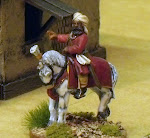NOTE: Having been asked about the availability of the Non-slip Plastic Liner I used, I can tell you locally in Australia, I have found it in both Dollar stores and Bunnings Warehouse. I did find it internationally available from AliExpress here. Hope that helps.
 |
| This is the finished piece. |
 |
| Cut out an appropriate section of strong card, large enough to cover the roof. |
 |
| Try to utilise a "natural" bend in your card to act as the roof's peak |
 |
| A close up of the "Non-slip Plastic Liner" which should be available in any home depot/department or hardware store for a very reasonable price. |
 |
| With the aid of a cutting mat, ruler and sharp blade, cut the liner into 1cm strips... |
 |
| ...until you have enough to potentially cover the roof. |
 |
| Line up one of the strips with the bottom of the card... |
 |
| ...and glue it down. |
 |
| Put some glue beyond the first strip of tiles... |
 |
| ...and place the next strip, so that it sits partially on the first strip of tiles. |
 |
| Rinse and repeat, periodically checking down the edge to ensure the strips of tiles are straight and even. |
 |
| Eventually you end up with something like this. |
 |
| Stop your strips of tiles before you reach the "natural" bend. |
 |
| When both sides are done it should look like this. Let the glue dry properly... |
 |
| ...and then trim with scissors. |
 |
| Undercoat the tiles with black... |
 |
| ...and do a heavy drybrush in the terracotta color of your choice. |
 |
| I use earbud tubes for the ridge cap, which sounds a lot more gross than it is. |
 |
| Cut them to size and lie them in the gutter between the two roofs. Try to keep the roofs at the angle they are required for, because the capping may restrict them from bending more later. |
 |
| Weather the roof by painting individual tiles in natural colors that compliment your base colors. |
 |
| Viola! A cheap and easily method for pantile roofing. |






































































































